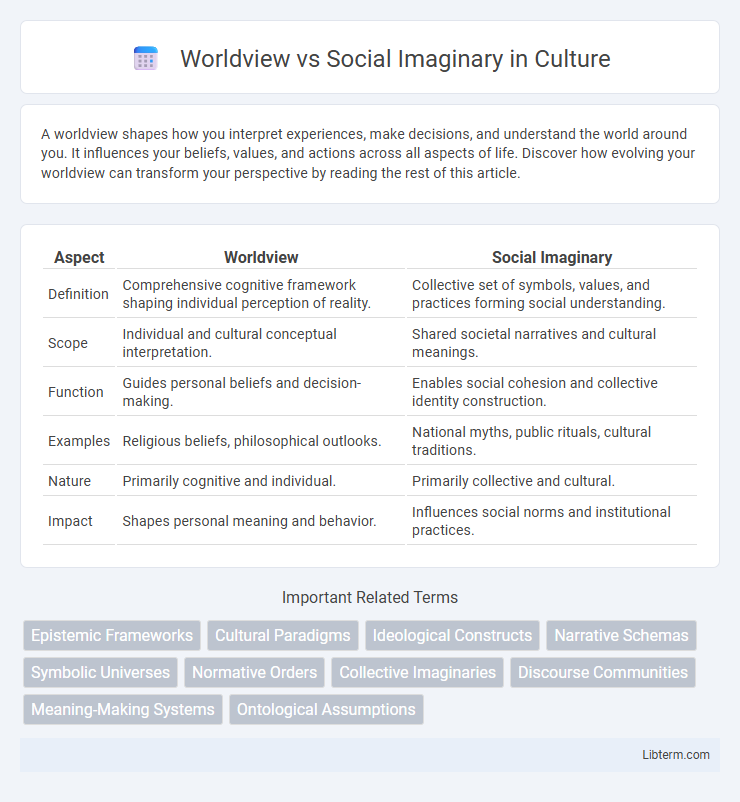A worldview shapes how you interpret experiences, make decisions, and understand the world around you. It influences your beliefs, values, and actions across all aspects of life. Discover how evolving your worldview can transform your perspective by reading the rest of this article.
Table of Comparison
| Aspect | Worldview | Social Imaginary |
|---|---|---|
| Definition | Comprehensive cognitive framework shaping individual perception of reality. | Collective set of symbols, values, and practices forming social understanding. |
| Scope | Individual and cultural conceptual interpretation. | Shared societal narratives and cultural meanings. |
| Function | Guides personal beliefs and decision-making. | Enables social cohesion and collective identity construction. |
| Examples | Religious beliefs, philosophical outlooks. | National myths, public rituals, cultural traditions. |
| Nature | Primarily cognitive and individual. | Primarily collective and cultural. |
| Impact | Shapes personal meaning and behavior. | Influences social norms and institutional practices. |
Defining Worldview: A Foundational Lens
Worldview serves as a foundational lens through which individuals interpret reality, encompassing core beliefs, values, and assumptions that shape perception and decision-making. It provides a comprehensive framework guiding how people understand their environment, culture, and existence. Unlike the social imaginary, which reflects collective social practices and shared meanings, worldview centers on the internalized cognitive schema influencing personal and societal behavior.
Understanding Social Imaginary: Collective Perceptions
Social imaginary refers to the set of collective understandings, symbols, and shared meanings that shape how societies perceive their world and social relationships. It encompasses the cultural narratives and social practices that guide collective behavior beyond individual beliefs or scientific knowledge. Understanding social imaginary involves analyzing how these collective perceptions influence social cohesion, identity, and institutional legitimacy within communities.
Core Differences: Worldview vs Social Imaginary
Worldview represents an individual's comprehensive framework for interpreting reality, encompassing beliefs, values, and assumptions about existence. Social imaginary refers to the shared set of symbols, narratives, and practices through which communities construct collective meaning and social norms. Core differences lie in worldview's focus on personal cognitive orientation, whereas social imaginary emphasizes communal meaning-making and cultural cohesion.
Origins and Influences: How Beliefs are Formed
Worldview originates from individual cognitive processes shaped by culture, religion, and personal experiences, forming a coherent system of beliefs about reality. Social imaginary emerges collectively through shared symbols, narratives, and practices that shape how communities understand their existence and social order. Both are influenced by historical context, education, and communication, but worldview emphasizes personal interpretation while social imaginary reflects collective meaning-making.
The Role of Culture in Shaping Perspectives
Worldview encompasses the deeply ingrained beliefs and values that individuals adopt, while social imaginary refers to the collective, shared understandings that shape social practices and institutions. Culture plays a crucial role in shaping both by embedding symbols, narratives, and rituals that influence how people interpret reality and interact within societies. These cultural elements continuously evolve, reinforcing the connection between personal perceptions and communal meanings in diverse social contexts.
Dynamics of Change: Evolution of Worldviews and Social Imaginaries
Worldviews and social imaginaries evolve through complex social, cultural, and historical processes that alter collective interpretations and shared meanings over time. Shifts in technology, politics, and environmental contexts drive the transformation of these constructs, influencing how societies understand reality and organize social life. Continuous interaction between individual cognition and communal narratives fuels the dynamic reconfiguration of worldviews and social imaginaries, reflecting adaptive responses to changing conditions.
Worldview’s Impact on Individual Identity
Worldview shapes individual identity by providing a comprehensive framework through which people interpret their experiences, values, and beliefs, influencing their sense of self and purpose. Unlike the broader social imaginary, which reflects collective symbols and shared meanings within a society, worldview operates at the personal level, affecting decision-making and behavior. This internalized perspective helps individuals navigate cultural norms and societal expectations, reinforcing their unique identity within a social context.
Social Imaginary and Collective Behavior
Social imaginary refers to the shared set of values, symbols, and meanings that shape how a community understands and interacts with its social reality. This collective framework influences collective behavior by guiding norms, expectations, and social practices that individuals internalize and enact within their group. The power of the social imaginary lies in its ability to create a cohesive identity and coordinated action among members of a society.
Interactions and Overlaps: Where Lines Blur
Worldview shapes individual perceptions and beliefs, while the social imaginary constructs collective understandings within a culture. Interactions occur as personal worldviews are influenced by, and in turn influence, the broader social imaginary, leading to dynamic overlaps. These blurred lines highlight how shared symbols and narratives continuously evolve through both individual and communal engagement.
Relevance in Modern Society: Why These Concepts Matter
Worldview shapes individual perception and decision-making frameworks, influencing behavior and cultural norms, while social imaginary encompasses the collective symbols, stories, and practices that bind societies together. Understanding these concepts is crucial for addressing social cohesion, policy development, and intercultural communication in an increasingly globalized world. Their relevance lies in navigating identity politics, fostering inclusive communities, and managing the complexities of modern social dynamics.
Worldview Infographic

 libterm.com
libterm.com